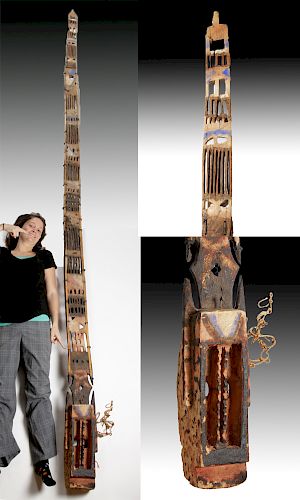Early 20th C. Dogon Wood Plank Mask (Sirige)
Lot 35
About Seller
Artemis Fine Arts
686 S Taylor Ave, Ste 106
Louisville, CO 80027
United States
Selling antiquities, ancient and ethnographic art online since 1993, Artemis Gallery specializes in Classical Antiquities (Egyptian, Greek, Roman, Near Eastern), Asian, Pre-Columbian, African / Tribal / Oceanographic art. Our extensive inventory includes pottery, stone, metal, wood, glass and textil...Read more
Categories
Estimate:
$5,000 - $8,000
Absentee vs Live bid
Two ways to bid:
- Leave a max absentee bid and the platform will bid on your behalf up to your maximum bid during the live auction.
- Bid live during the auction and your bids will be submitted real-time to the auctioneer.
Bid Increments
| Price | Bid Increment |
|---|---|
| $0 | $25 |
| $300 | $50 |
| $1,000 | $100 |
| $2,000 | $250 |
| $5,000 | $500 |
| $10,000 | $1,000 |
| $20,000 | $2,500 |
| $50,000 | $5,000 |
| $100,000 | $10,000 |
| $200,000 | $20,000 |
About Auction
By Artemis Fine Arts
May 10, 2018
Set Reminder
2018-05-10 10:00:00
2018-05-10 10:00:00
America/New_York
Bidsquare
Bidsquare : Fine Ethnographic / Asian / Ancient Art
https://www.bidsquare.com/auctions/artemis-gallery/fine-ethnographic-asian-ancient-art-3213
Featuring antiquities from around the world including Pre-Columbian, Tribal, Classical, Asian, so much more! Artemis Fine Arts info@artemisfinearts.com
Featuring antiquities from around the world including Pre-Columbian, Tribal, Classical, Asian, so much more! Artemis Fine Arts info@artemisfinearts.com
- Lot Description
West Africa, Mali, Dogon people, ca. early to mid 20th century CE. A massive, impressive, hand-carved wooden mask capped by an incredible tall staff, carved from the branch of a single tree. The sirige mask is one of the most important in the Dogon culture. The mask itself features a face with a rectangular form and deep, hollowed out channels for the eyes. A sharply acute angle in the center of the face acts as the nose. There is no mouth. Two long, projecting rectangles with deep grooves down their length form ears. The edges of the mask are perforated and thick twisted rope is wound through them, forming supports for wearing the mask. Towering above the mask is a massive plank with rattan lining its edges and openwork lines and triangles cut throughout its length. Blue, red, white, and dark brown / black organic pigments provide further decoration. Size: 6.5" W x 162.5" H (16.5 cm x 412.8 cm)
The Awa association of men in Dogon society conduct elaborate masquerades as funerary rituals, with their form used to assist the deceased on his journey to the afterlife. The sirige mask is worn by dancers in the days following the death of an adult man, and its immense height symbolizes the generations of the deceased's family, while the straight line shape is meant to connect the worlds of the sun and the Earth. Incredibly, the mask is held in the dancer's teeth and whirled in sweeping motions that represent the arc of the sun in the sky.
See similar examples at the Metropolitan Museum of Art (https://metmuseum.org/art/collection/search/309859) and the Art Institute of Chicago (http://www.artic.edu/aic/collections/artwork/18817).
Provenance: the late Allen A. Davis collection, Santa Fe, New Mexico, USA
All items legal to buy/sell under U.S. Statute covering cultural patrimony Code 2600, CHAPTER 14, and are guaranteed to be as described or your money back.
A Certificate of Authenticity will accompany all winning bids.
We ship worldwide and handle all shipping in-house for your convenience.
#128395The piece was likely used at least once. Expected signs of wear, with small areas of inactive insect damage and losses to pigment.Condition
- Shipping Info
-
All shipping is handled in-house for your convenience. Your invoice from Artemis Gallery will include shipping calculation instructions. If in doubt, please inquire BEFORE bidding for estimated shipping costs for individual items.
-
- Buyer's Premium



 EUR
EUR CAD
CAD AUD
AUD GBP
GBP MXN
MXN HKD
HKD CNY
CNY MYR
MYR SEK
SEK SGD
SGD CHF
CHF THB
THB
















